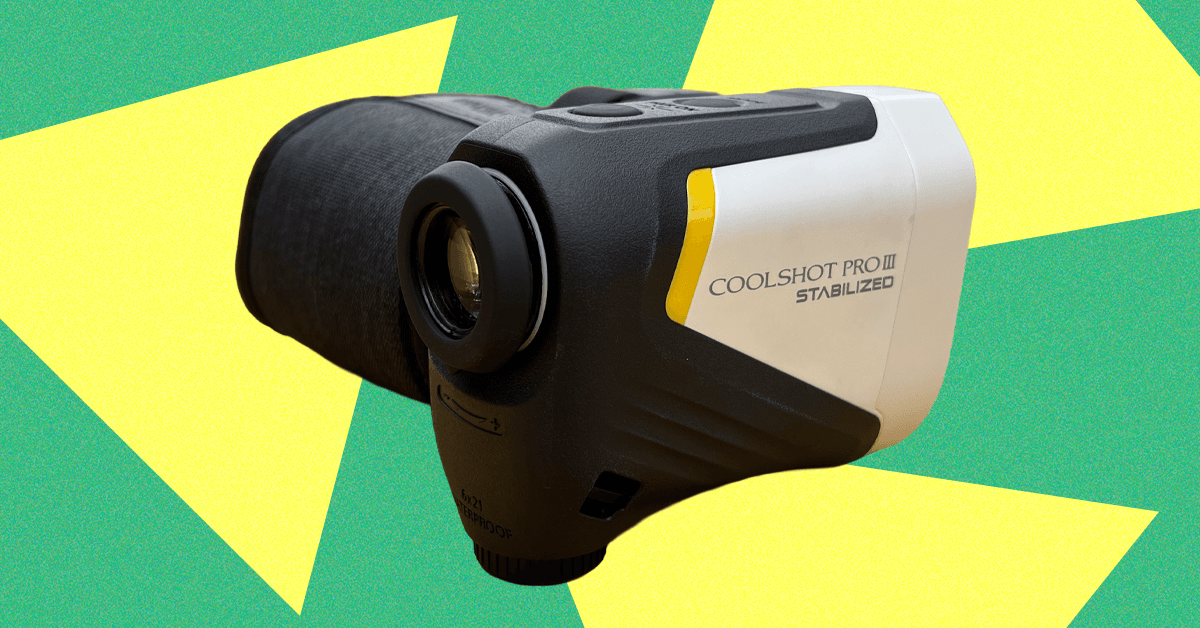The Best Golf Rangefinders (2025)

All products featured on WIRED are independently selected by our editors. However, we may receive compensation from retailers and/or from purchases of products through these links. Learn more.
Golf is a fiendishly difficult game, as any avid golfer can attest, so anything that gives you an edge is worthy of investment. The best golf rangefinders offer pinpoint precision in any conditions, helping you accomplish the Herculean task of driving a tiny dimpled ball into a small hole from hundreds of yards away. For this list, we've pitted some of the very best rangefinders you can buy at multiple price ranges against one another over several rounds to gauge traits like accuracy, durability, features, and ease of use in various conditions.
We're always testing new models, so be sure to check back for the latest and greatest. Looking for more help with your game, or something for a loved one? Be sure to check out our list of the Best Golf Gifts, and other handy outdoor guides like the Best Fitness Trackers, the Best Workout Headphones, and the Best Coolers.
Updated November 2025: We've added the Mileseey GenePro G1 hybrid rangefinder, and updated copy and pricing with the latest information.
What Kind of Rangefinder Features Should I Expect?
Rangefinders can include a slew of features, which makes shopping as a novice confusing. The most important options in our testing include slope measurement (elevation gained or lost), a pinspotter (which zeroes in on the pin when tracking), weatherproofing, tournament mode, a cart magnet, and last but definitely not least, image stabilization.
Other handy options from some of our favorites include an OLED display for a bright targeting overlay, and Bluetooth connectivity to pair with apps or other golf devices, such as a smartwatch for GPS data. The fancier you get, the more features you'll find, including options like wind speed and direction, element compensation, and more. That said, there is such a thing as too much data, and you'll usually pay a premium as the feature count goes up.
As you start to research rangefinders, you'll likely read about laser versus GPS tracking. The majority of rangefinders we test rely mainly on laser tracking, but some, like the Garmin Z30, can receive GPS data from a paired device or smartwatch. Others, like the Mileseey GenePro G1, can integrate GPS directly via an onboard screen, though this can drain the battery more quickly. You can also get GPS data from a separate app on your phone or smartwatch, often for free, which can supplement laser-only rangefinders for blind shots. We rely on laser tracking as the most important guideline and performance metric for our testing, but when properly integrated, GPS can be a handy addition, especially for playing new courses or navigating longer holes.
Slope in relation to golf rangefinders is essentially the measurement of how many yards upward or downward the ball must travel to reach its destination. It is a key feature for the best rangefinders to provide accurate club data. All of the rangefinders we test can be set to measure slope, including both the true distance and how long a shot will actually play by accounting for elevation gained or lost to improve shot accuracy. Since slope measurement is generally barred for tournaments, each model also offers a “Tournament Mode” that lists the actual distance only, usually signaled by an LED or stripe on the device.
What Kind of Magnification Do I Need?
All of the rangefinders on our list offer a minimum of 6X object magnification, adjustable with a lens focus. That magnification level worked great in tests for any distance I measured. Some models go further to 7X magnification or higher, which may be useful for those who need additional visual assistance, but for most players, 6X should suffice.
Is a Rangefinder's Maximum Range Important?
The short answer is probably not. Every rangefinder on our list offers enough range for any hole on the course, with a minimum of 700 yards for our cheapest recommended model. Any more than that could theoretically come into play, but it’s mostly stat padding by the manufacturer.
The Nikon Coolshot Pro III Stabilized is the Cadillac of rangefinders, offering luxe features and a silky smooth ride that makes finding your elevation, shot, and hazard distances a pleasure. Image stabilization freezes shaky targets in place like an ace pilot on the stick, making tracking quick and simple in challenging conditions.
I love being able to scan the horizon for hazards, while the flag lock function focuses on a flagstick perfectly with a telltale buzz. Four slope modes provide options for any situation, including tournaments, and the compact design makes it easy to handle. The lack of a magnet means you can’t stick it to your cart, and there aren't many included accessories, but the Pro III’s performance makes it an easy choice as my top pick.
Specs Magnification/Range 6X/1,200 yards Weatherproofing Waterproof up to 10 minutes at 1 meter Battery Life Up to 2,700 measurements Accessories Soft case, battery Warranty Five-year warranty If you’re after a rangefinder on a tight budget, the Shot Scope Pro L2 is all you need. This light and compact model provides impressive accuracy, standing tall with rangefinders three times the price, usually within a margin of a yard or two. Its powerful magnet lets you stick it to your cart or bag, and you’ll get good accessories like a hard case, lens cleaner, and carabiner.
The single-color reticle system isn’t as handy as pricier, colored options, and the optics aren’t quite as clear. But with its durable design, adaptive slope reading, a vibrating pin finder, and extras like an app for course maps, it’s hard to beat this package for the price.
Specs Magnification/Range 6X/700 yards Weatherproofing Basic water resistance Battery Life Up to 5,800 measurements Accessories Waterproof hard case, carabiner, lens cleaner Warranty Two-year warranty
The Mileseey GenePro G1 isn’t the easiest device to master, but if you’re looking for a hybrid GPS/laser rangefinder with everything but the proverbial kitchen sink, this is the best I’ve tested. I thought the AMOLED side screen might be overkill, but once I got used to it, I really enjoyed (and relied on) having all that information in one place. The touchscreen is responsive and inviting, letting you combine GPS and live measurements, add scores with the swipe of a finger, and adjust settings for performance that feels equal parts rangefinder and digital caddie.
The viewfinder is crystal clear, with a bright target reticle and an accurate pin finder that make it easy to measure long distances. The slope feature incorporates elements like humidity, and you can keep track of your progress in the Mileseey app. There's even an innovative ball-to-pin mode that can measure from your cart to the green, or chart layups, something that came in handy when I hit another fairway on a recent round. I wish the three-button control system were better labeled, and the G1’s battery readout bizarrely only appears once it needs a charge, but it lasted multiple rounds with heavy use. For those who want all their info in one place, the G1 is a slick setup.
Specs Magnification/Range 6X/1,300 yards Weatherproofing IP65 Battery Life Up to 24 hours per charge (four to five rounds) Accessories Hard case, charge cable, lens cleaner Warranty 10-year limited warranty The Garmin Approach Z30 is a simplified rangefinder with a sturdy design and solid all-around performance. It has a strong magnet for sticking on your cart, an intuitive (and basic) menu, and clear visuals via its transparent OLED display with a bright red targeting reticle for accurate reads with or without slope measurement.
Where the Z30 really steps up is when paired with a Garmin golf watch like the Approach S12. The Z30 sends laser targets directly to the watch, while the watch shares GPS flag distance from the front and back of the green right in the eyepiece, which really comes in handy. The Z30’s main downside lacks extras like image stabilization—a bummer at this price—but if you’re a Garmin user with a steady hand, it’s a great combo.
Specs Magnification/Range 6X/1,300 yards Weatherproofing IPX7 Battery Life Up to one year Accessories Waterproof hard case, carabiner, hand strap, lens cleaner, battery Warranty One-year limited warranty
There are tons of rangefinders available in multiple styles, and while not every model makes our top list, they could still be a good fit for your needs.
- Vortex Optics Anarch for $350: The Vortex Anarch is a loaded rangefinder, offering clear optics, a stout magnesium chassis with a built-in magnet, and plenty of accessories. It piles on the features (maybe too many), which can make using the menu a bit confusing at first. Highlights include image stabilization, a pinspotter, and multiple brightness levels for targeting, though none of those worked as effectively or intuitively as my top pick. It’s still a good rangefinder, especially since you can usually find it well below its $600 MSRP, and the “unlimited” lifetime warranty alone makes it worth considering at its usual $400 street price.
How We Test Golf Rangefinders
We test rangefinders exactly how they’re intended to be used: on the golf course. Sure, they’re fun to mess with elsewhere—they’re essentially just small telescopes—but the only way to properly access performance is to use them constantly on the links. I tested all of these rangefinders across multiple local courses, using them back-to-back (to back) for reference, which sometimes annoyed my fellow golfers, but helped gauge accuracy, clarity, and ease of use. I tested all their features, from menu settings and pin targeting, to how well their side magnets held onto my cart. I also treated them as roughly as I’d expect you will.
Power up with unlimited access to WIRED. Get best-in-class reporting and exclusive subscriber content that's too important to ignore. Subscribe Today.
wired





